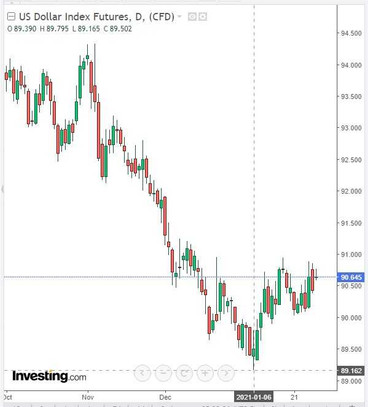As reported last Wednesday in the US Department of Energy, oil reserves in the country fell by 9.91 million barrels (against the forecast of +0.43 million).
Oil market analysts attribute such a significant reduction in inventories to growth in exports and a reduction in imports.
However, this positive news for the oil market did not provide significant support to oil prices. Futures for the main grades of Brent and WTI remain in ranges near the marks of 56.00 and 53.00 dollars per barrel, respectively.
It seems that oil traders do not really believe in the growth prospects of quotations due to problems with the availability of vaccines against coronavirus, focusing also on the dynamics of global stock indices. And today they are declining again after a strong fall last Wednesday.
Investors remain worried about the rise in the number of coronavirus infections in Europe and Asia, new quarantine restrictions, as well as protracted negotiations in the US Congress over a $ 1.9 trillion economic stimulus program.
European plans to contain the coronavirus are under threat from supply disruptions and vaccine shortages. Market participants are concerned that European countries may not be able to vaccinate the most vulnerable populations and fully resume economic activity in the near future.
At the same time, the dollar continues to be in demand, intercepting the status of a defensive asset even from the yen and franc.
On Wednesday, the DXY dollar index rose markedly, climbing to an intra-week high of 90.88. DXY futures are traded near 90.64 at the start of the European session today, the close price of Wednesday's trading day.

Despite the fact that last Wednesday, when the 2-day meeting ended, the Fed leaders confirmed their intention to continue to keep the interest rate in the range of 0.0%-0.25% and the program of asset repurchase in the amount of $ 120 billion monthly, market participants continue to discuss the topic of the likelihood of curtailing the stimulus program by the Fed, which also supports the dollar.
Today, oil market participants will be watching the publication (at 18:00 GMT) of the weekly data of the oilfield services company Baker Hughes on the number of active rigs in the United States. After their number reached 888 in November 2019, the number of active rigs in the United States subsequently began to decline, and in March 2020, the pace of closure of oil rigs accelerated significantly due to a sharp drop in oil prices.
On the week before last, their number was 289 (against 287, 275, 267, 264 in the previous reporting periods). It is obvious that the number of oil companies in the US is growing again, which is a negative factor for oil prices. Another rise is likely to have a negative impact on oil quotes, but, most likely, only in the short term.
In fact, the dynamics of the oil market at the moment will be determined by the dynamics of the dollar and stock indices, the volume of oil production in the world, as well as information regarding the situation with the coronavirus.
Also, participants in the entire financial market today will be watching the publication at 13:30 (GMT) of important macro data for the United States, including data on income / spending of Americans and personal consumption expenditure. These are indirect inflationary indicators that can affect the short-term dynamics of the dollar. The growth of indicators will have a positive effect on the dollar quotes, and vice versa, a decrease in indicators may cause a weakening of the dollar.
But in any case, when these macro data are published, volatility may increase in trading not only in USD, but throughout the entire financial market, especially if the data differs greatly from the forecast values.





